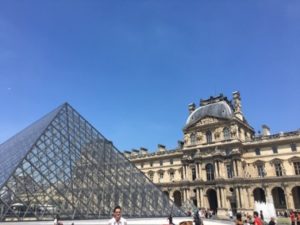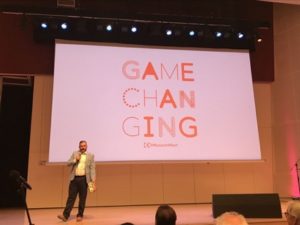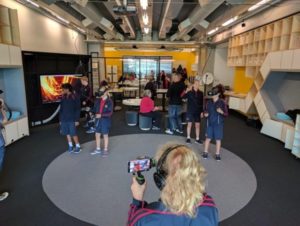Changing Museum Practices to Change the World

In June, I was fortunate to have the opportunity to participate in two European museum conferences. Communicating the Museum (CTM): The Power of Education was held in Paris from June 19-22nd. CTM is “the world’s leading arts communication conference encourages dialogue between museums, drives innovation, inspires new ideas, explores trends in communication strategies and fosters lasting relationships among worldwide institutions.”
This year’s convening was a first in bringing together global leaders from the communications and education fields to discuss the role of museums and learning. As Corrine Estrada, communications expert and co-founder of CTM states, “Artistic education and engagement are essential to a museum’s social mission. Education is a soft power, building a better world of collaboration, emotion, openness and happiness. As Nelson Mandela said, Education is the most powerful weapon which you can use to change the world.” So, as museums how can we use our power to change the world? This urgent topic was addressed through multiple talks, workshops, and discussions during our time at CTM in Paris.

Change was also the focus of another gathering of museum professionals in Rotterdam from June 26-28th. “Museum Game Changers” was this summer’s MuseumNext theme. As its founder, Jim Richardson, said in his welcome statement, “In thinking about the role which museums can play in the world, it seems more pressing now than at any time since I started working in the museum sector twenty years ago. What has inspired me has been the response to a rapidly changing world from museums. There seems to be a desire for our institutions to be places for difficult questions to be asked, to use our place in society to challenge and even in some cases protest.”
So what are we as museums doing to make social, political, and environmental changes to equip future generations to thrive in our ever-changing world? Inspired by examples shared by global thought leaders at both conferences, below are some questions that museums should be asking themselves if they truly want to reinvent the field and to use their power to change the world.
-

Photo: Shaz Hussain speaking at MusuemNext, Rotterdam, 2017. Credit: Museum Next Is your museum an inclusive and equitable institution from the inside out? Is your staff reflective of the communities with which they engage or hope to? Does your team embrace difference and exhibit cultural competency? Diversity, inclusion, and equity practices and values are crucial for the relevance and future of museums. First, we must develop a shared language that is not based on a deficit model. Shaz Hussain, Collections Assistant at the Royal Air Force Museum London, eloquently addresses this issue and offers us more inclusive alternatives: The Problem with Diversity. Sara Wajid, Head of Interpretation at Birmingham Museum and Art Gallery in the U.K. and founder of Museum Detox, a network for Black, Asian, Minority, Ethnic Workers (BAME) stated in her talk, “We Walk Amongst You: how the shy activists in our midst will reach the 21st century visitor.” She encouraged museums to focus internally. “By building solidarity between LGTBQ workers, BAME staff, feminists, unionists, and activists of all stripes within your own workforce you can radically alter the cultural DNA of your museum and become relevant to the next generation of visitors.”
- As museums, are we engaging our audiences on an emotional level? True learning happens when we emotionally engaged. Are we considering personal and emotional connections when we develop programs and exhibitions? Dr. David Sander, University of Geneva Professor in the Department of Psychology and Director of the Laboratory for the study of Emotion, Elicitation, and Expression stressed this importance in his opening talk at CTM, The Emotional Brain and Learning
- Is your institution breaking the rules, disrupting the norm, and encouraging people to think differently? If we want to truly create change, then we must rethink our traditional approaches, and take risks and think like artists. Will Gompertz, Arts Editor for the BBC, U.K. inspired such thinking in his CTM talk, All Schools Should be Art Schools. Adam Lerner, Director and Chief Animator at the Museum of Contemporary Art Denver, encourages us to “not to die of excellence” and rather to strive for “awesomeness” and “to develop sophisticated programs without taking ourselves too seriously.” (How Not to Die of Excellence)
-

Student group at Te Papa’s Learning Lab. Credit: Te Papa Museum Is your museum activating its spaces and offering visitors engaging hands-on learning opportunities? Are you creating opportunities for social interaction and community-building within your museum? Some museums are leading the field in this area and fostering the development of the core competencies of collaboration, creativity, critical thinking, and STEAM skills. Miri Young, Head of Learning Innovation, at Te Papa, the National Museum of New Zealand, and her team are transforming learning through both high and low tech in their learning lab, Hīnātore.
Rio de Janerio ’s Museum of Tomorrow is also inspiring visitors to “stop being simply consumers and become instead creators of their own tomorrows.” Marcelo Sabino, Director of The Museum of Tomorrow’s Laboratory, discussed how the lab promotes scientific, technological, and artistic participation and stimulate thinking about the “processes that are transforming our world and reflect on the consequences of our actions.” Anna Cutler, Director of Learning at the U.K.’s Tate Modern discussed her museum’s initiative, Tate Exchange, as “a civic and emotional space,” — a platform for people to take part in, and contribute to experiences and ideas that make art relevant to our lives today. Tate Exchange, an entirely new program for the museum, explores how art makes a difference in society; working with the collection, artists, partners, and the public on socially relevant themes. Tate Exchange occupies an entire floor of the museum and is also an online platform for wider public engagement. It includes international artists, contributors from different fields, the public, and over 50 Associates, who work within and beyond the arts, on creating nine months of participatory programs, workshops, activities and debates.
Inspired by these brave models of experimentation, risk, tolerance, and emotional connection, I challenge you make changes in your museum practice that will change the world!
Karleen Gardner is Director of Learning Innovation at the Minneapolis Institute of Art (Mia) and is a frequent presenter at national and international conferences. She is a peer reviewer for the Journal of Museum Education.

